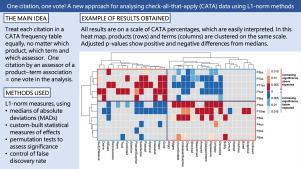一次引用,一票!用l1范数方法分析全检(CATA)数据的新方法
IF 4.9
1区 农林科学
Q1 FOOD SCIENCE & TECHNOLOGY
引用次数: 0
摘要
根据“一次引用,一票”的原则,提供了一个统一的分析CATA产品数据的框架。CATA数据来自于研究,其中A评估者通过检查所有适用的T项来描述样本,从而评估P个产品。无论评估者、产品或术语如何,给予每个引用相同的权重,导致基于L1规范的分析,其中中位数绝对偏差是离散度的度量。提出了五种排列检验来回答下列问题。产品有什么不同吗?哪些条款的产品不同?在每个术语中,哪些产品不同?哪些产品对不同?每对产品在哪些方面不同?此外,我们还展示了如何按照“一次引用,一票”原则对产品和术语进行聚类,以及如何使用l1 -范数(L1-PCA)进行主成分分析,以在几个维度上可视化CATA结果。排列测试、聚类方法和L1-PCA共同提供了一个统一的方法,提供了以引用百分比衡量的可靠结果。所提出的方法是用一个数据集来说明的,其中100名消费者使用34个CATA术语评估了11种产品。提供了R代码来执行分析。本文章由计算机程序翻译,如有差异,请以英文原文为准。

One citation, one vote! A new approach for analysing check-all-that-apply (CATA) data using L1-norm methods
A unified framework is provided for analysing check-all-that-apply (CATA) product data following the “one citation, one vote” principle. CATA data arise from studies where A assessors evaluate P products by describing samples by checking all of the T terms that apply. Giving every citation the same weight, regardless of the assessor, product, or term, leads to analyses based on the L1 norm where the median absolute deviation is the measure of dispersion. Five permutation tests are proposed to answer the following questions. Do any products differ? For which terms do products differ? Within each of the terms, which products differ? Which product pairs differ? On which terms does each product pair differ? Additionally, we show how products and terms can be clustered following the “one citation, one vote” principle and how principal component analysis using the L1-norm (L1-PCA) can be applied to visualise CATA results in few dimensions. Together, the permutation tests, clustering methods, and L1-PCA provide a unified approach that provides robust results measured in citation percentages. The proposed methods are illustrated using a data set in which 100 consumers evaluated 11 products using 34 CATA terms. R code is provided to perform the analyses.
求助全文
通过发布文献求助,成功后即可免费获取论文全文。
去求助
来源期刊

Food Quality and Preference
工程技术-食品科技
CiteScore
10.40
自引率
15.10%
发文量
263
审稿时长
38 days
期刊介绍:
Food Quality and Preference is a journal devoted to sensory, consumer and behavioural research in food and non-food products. It publishes original research, critical reviews, and short communications in sensory and consumer science, and sensometrics. In addition, the journal publishes special invited issues on important timely topics and from relevant conferences. These are aimed at bridging the gap between research and application, bringing together authors and readers in consumer and market research, sensory science, sensometrics and sensory evaluation, nutrition and food choice, as well as food research, product development and sensory quality assurance. Submissions to Food Quality and Preference are limited to papers that include some form of human measurement; papers that are limited to physical/chemical measures or the routine application of sensory, consumer or econometric analysis will not be considered unless they specifically make a novel scientific contribution in line with the journal''s coverage as outlined below.
 求助内容:
求助内容: 应助结果提醒方式:
应助结果提醒方式:


